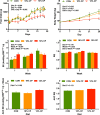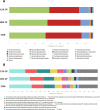Low Protein-High Carbohydrate Diets Alter Energy Balance, Gut Microbiota Composition and Blood Metabolomics Profile in Young Pigs
- PMID: 32094453
- PMCID: PMC7040010
- DOI: 10.1038/s41598-020-60150-y
Low Protein-High Carbohydrate Diets Alter Energy Balance, Gut Microbiota Composition and Blood Metabolomics Profile in Young Pigs
Abstract
Reducing dietary crude protein (CP) beyond a certain threshold leads to poor growth performance in pigs; however, the underlying mechanisms are not well understood. Following an adaption period, thirty-seven weaned pigs were weight matched (8.41 ± 0.14 kg), housed individually and randomly assigned into three groups with different dietary CP levels: 24% CP (CON; n = 12), 18% CP (n = 12) and 12% CP (n = 13) for 28 days. The body weight was not different between the CON and 18% CP diets, but 12% CP significantly decreased body weight after day 21. Compared to the CON, pigs fed with 12% CP decreased feed intake day 17 onwards. The 12% CP diet increased the energy expenditure during week 1 compared to the CON. The 12% CP influenced starch and sucrose, nitrogen, and branched-chain amino acids metabolism pathways. The feces of pigs fed with 12% CP were less enriched in Prevotella, but had higher relative abundance of Christensenedilaceae, Aligiphilus and Algoriphagus than CON and 18% CP. Overall, reducing dietary CP by 50%, but not by 25%, significantly influenced the physiological responses in nursery pigs. The pigs fed with low or standard protein diets had differential bacterial communities in their feces as well as serum metabolomics profile.
Conflict of interest statement
The authors declare no competing interests.
Figures





References
Publication types
MeSH terms
Substances
LinkOut - more resources
Full Text Sources
Medical
Miscellaneous

